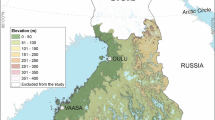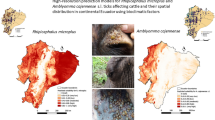Abstract
The brown ear tick Rhipicephalus appendiculatus, vector of East Coast fever (ECF) and related cattle diseases caused by Theileria parva has never been reported from the Horn of Africa. Habitat suitability for this tick species was predicted using Maxent modelling technique based on R. appendiculatus records in Sub-Saharan Africa. Two models were developed: the first is based on the tropical R. appendiculatus distribution and the one is based on the distribution records in the temperate region of Sub-Saharan Africa. The tropical model shows favourable habitat in much of the Ethiopian highlands. The whole Djibouti, the south eastern Ethiopian lowlands, majority of Somalia and Eritrea were found to be not suitable for the survival and development of this tick species. Highly suitable areas occur in areas which have moderate temperature and high precipitation. Introductions of R. appendiculatus into the Horn of Africa probably have been prevented by the natural barrier between the known R. appendiculatus distribution range in East Africa and the Horn of Africa. The effect of an introduction of R. appendiculatus and thereby ECF into the Horn of Africa could be catastrophic since the cattle in this area have no immunity against ECF, and mortality might be considerable in all age groups of cattle.





Similar content being viewed by others
References
Cumming GS (1998) Host preference in African ticks (Acari: Ixodida): A quantitative data set. Bull Entomol Res 88:379–406
Cumming GS (1999) Host distributions do not limit the species ranges of most African ticks (Acari: Ixodida). Bull Entomol Res 89:303–327
Cumming GS (2000) Using habitat models to map diversity: pan-African species richness of ticks (Acari: Ixodida). J Biogeogr 27:425–440
De Meyer M, Robertson MP, Mansell MW, Ekesi S, Tsuruta K, Mwaiko W, Vayssieres JF, Peterson AT (2010) Ecological niche and potential geographic distribution of the invasive fruit fly Bactrocera invadens (Diptera, Tephritidae). Bull Entomol Res 100(1):35–48
Elith J, Graham C, Anderson R, Dudý′k M, Ferrier S, Guisan A, ijmans R, Huettmann F, eathwick J, Lehmann A, Li J, Lohmann L, Loiselle B, Manion G, Moritz C, Nakamura M, Nakazawa Y, Overton J, Peterson A, Phillips S, Richardson K, Scachetti-Pereira R, Schapire R, Sobero′n J, Williams S, Wisz M, Zimmermann N (2006) Novel methods improve prediction of species’ distributions from occurrence data. Ecography 29:129–151
Elith J, Kearney M, Phillips S (2010) The art of modelling range-shifting species. Methods Ecol Evol 1:330–342
Elith J, Phillips S, Hastie T, udík M, Chee Y, Yates C (2011) A statistical explanation of MaxEnt for ecologists. Divers Distrib 17:43–57
Estrada-Pena A (2001) Climate warming and changes in habitat suitability for Boophilus microplus (Acari : Ixodidae) in Central America. J Parasitol 87(5):978–987
Estrada-Pena A (2006) Prediction of habitat suitability for ticks. Century of Rickettsiology: Emerging, Reemerging Rickettsioses, Molecular Diagnostics, and Emerging Veterinary Rickettsioses 1078:275–284
Estrada-Pena A, Bouattour A, Camicas JL, Guglielmone A, Horak I, Jongejan F, Latif A, Pegram R, Walker AR (2006a) The known distribution and ecological preferences of the tick subgenus Boophilus (Acari: Ixodidae) in Africa and Latin America. Exp Appl Acarol 38(2–3):219–235
Estrada-Pena A, Corson M, Venzal JM, Mangold AJ, Guglielmone A (2006b) Changes in climate and habitat suitability for the cattle tick Boophilus microplus in its southern Neotropical distribution range. J Vector Ecol 31(1):158–167
Estrada-Pena A, Garcia Z, Sanchez H (2006c) The distribution and ecological preferences of Boophilus microplus (Acari : Ixodidae) in Mexico. Exp Appl Acarol 38(4):307–316
Guisan A, Thuiller W (2005) Predicting species distribution: offering more than simple habitat models. Ecol Lett 8:993–1009
Guisan A, Zimmermann N (2000) Predictive habitat distribution models in ecology. Ecol Model 135:147–186
Hijmans R, Cameron S, Parra J, Jones P (2005) Very high resolution interpolated climate surfaces for global land areas. Int J Climatol 25:1965–1978
Holt A, Salkeld D, Fritz C, Tucker J, Gong P (2009) Spatial analysis of plague in California: niche modeling predictions of the current distribution and potential response to climate change. Int J Health Geogr 8:38
Julla I (1985) Theileriosis in southern Sudan. Immunization against Theileriosis in Africa. In: Irvin AD (ed) Immunization against Theileriosis in Africa. ILRAD/FAO, Nairobi, pp 27–30
Kulkarni M, Desrochers R, Kerr J (2010) High resolution niche models of malaria vectors in Northern Tanzania: a new capacity to predict malaria risk?? PLoS ONE 5:e93–e96
Lessard P, L’Eplattenier R, Norval RA, Kundert K, Dolan TT, Croze H, Walker JB, Irvin AD, Perry BD (1990) Geographical information systems for studying the epidemiology of cattle diseases caused by Theileria parva. Veterinary Records 126(11):255–262
Madder M, Speybroeck N, Brandt J, Tirry L, Hodek I, Berkvens D (2002) Geographic variation in diapause response of adult Rhipicephalus appendiculatus ticks. Exp Appl Acarol 27(3):209–221
Mwambi H, Baumgartner J, KP H (2000) Ticks and tick-borne diseases: a vector-host interaction model for the brown ear tick (Rhipicephalus appendiculatus). Stat Methods Med Res 9:279–301
Norval R, Perry B, Gebreab F, Lessard P (1991) East coast fever: a problem of the future for the horn of Africa? Prev Vet Med 10:163–172
Pegram R, Hoogstraal H, assef H (1981) Ticks (Acari: Ixodoidea) of Ethiopia. I. Distribution ecology and host relationships of species infesting livestock. Bull Entomol Res 71:339–359
Perry B, Kruska R, Lessard P, Norval R, Kundert K (1991) Estimating the distribution and abundance of Rhipicephalus appendiculatus in Africa. Prev Vet Med 11:261–268
Phillips S, Dudik M (2008) Modeling of species distributions with Maxent: new extensions and a comprehensive evaluation. Ecography 31:161–175
Phillips S, Anderson R, Schapire R (2006) Maximum entropy modeling of species geographic distributions. Ecol Model 190:231–259
Randolph S (1997) Abiotic and biotic determinants of the seasonal dynamics of the tick Rhipicephalus appendiculatus in South Africa. Med Vet Entomol 11:25–37
Stabach J, Laporte N, Olupot W (2009) Modeling habitat suitability for grey crowned-cranes (Balearica regulorum gibbericeps) throughout uganda. Int J Biodivers Conserv 1(5):177–186
Sumarga E. 2011 A comparison of logistic regression, geostatistics and maxent for distribution modeling of a forest endemic. In: A pilot study on Lobel′s maple AT MT. Pizzalto, Italy. Faculty of geo-information science and earth observation of the University of Twenty. The Netherlands
Tonnesen M, Penzhorn B, Bryson N, Soltsz W, Masibigiri T (2004) Displacement of Boophilus decoloratus by Boophilus microplus in the Soutpansberg region, limpopo province South Africa. Exp Appl Acarol 32(3):199–208
Acknowledgments
I would like to thank Professor G.S. Cumming and the ILRI GIS service group for the provision of the presence records of R. appendiculatus.
Author information
Authors and Affiliations
Corresponding author
Rights and permissions
About this article
Cite this article
Leta, S., De Clercq, E.M. & Madder, M. High-resolution predictive mapping for Rhipicephalus appendiculatus (Acari: Ixodidae) in the Horn of Africa. Exp Appl Acarol 60, 531–542 (2013). https://doi.org/10.1007/s10493-013-9670-1
Received:
Accepted:
Published:
Issue Date:
DOI: https://doi.org/10.1007/s10493-013-9670-1




